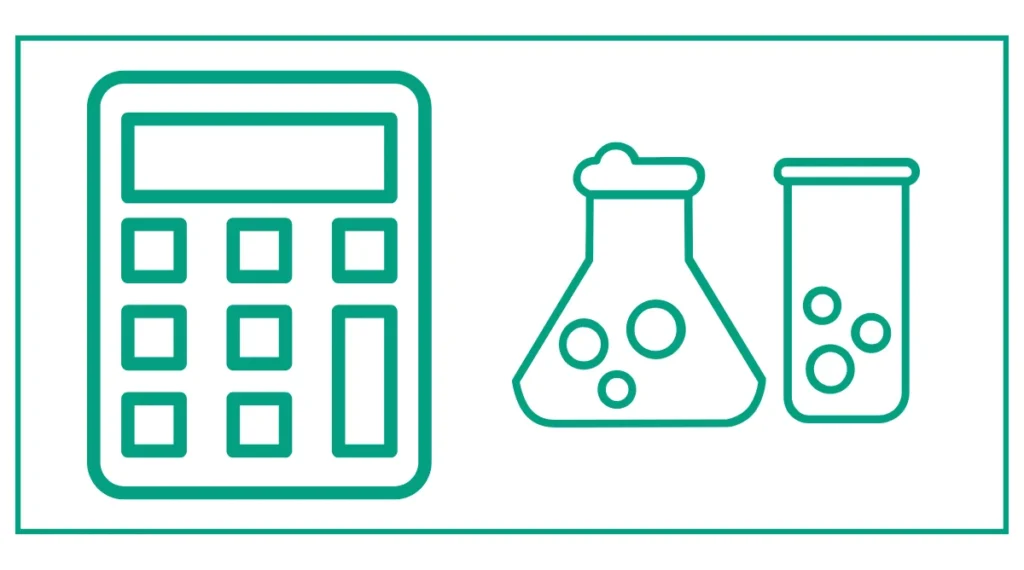The molarity calculator helps you calculate the mass required in grams for the molar solution.
Enter the formula weight, desired final volume, and desired concentration to determine the mass required.
The calculator also allows you to switch the desired final volume units from Litres to milliliters and microliters.
You can also switch the units of desired concentration from molar to Millimolar, Micromolar, Nanomolar, Picomolar, and Femtomolar.
In case you don’t know, molarity is the amount of a solute per liter of a solution in moles. Molarity is also called a solution’s molar concentration.
M = n/V
Where n = moles, V = volume of the solution

What is Molarity?
Molarity is a measure of the concentration of a solution, defined as the number of moles of solute per liter of solution. It is typically denoted by the unit M (molar). For example, a 1 M solution contains one mole of solute per liter of solution.
The Importance of Concentration in Chemistry
Concentration plays a vital role in various chemical processes and reactions. It affects reaction rates, equilibrium, and the properties of solutions. Accurate concentration calculations are crucial for:
- Preparing stock solutions for experiments
- Diluting concentrated solutions
- Determining the amount of reactants needed for a reaction
- Analyzing the results of chemical analyses
How to Use the Molarity Calculator
The molarity calculator is a user-friendly tool designed to simplify concentration-related calculations. Here’s a step-by-step guide on how to use this calculator effectively:
- Enter the formula weight (molecular weight) of the compound in g/mol.
- Input the desired final volume of the solution in liters (L).
- Specify the desired concentration in molar (M) units.
- Click the “Calculate” button.
- The calculator will display the mass of compound needed to prepare the solution.
Example 1: Preparing a Sodium Chloride Solution
Let’s say you need to prepare a 0.5 M solution of sodium chloride (NaCl) with a final volume of 1 L.
- Formula weight of NaCl = 58.44 g/mol (sodium is 22.99 g/mol, chlorine is 35.45 g/mol)
- Desired final volume = 1 L
- Desired concentration = 0.5 M
- Using the molarity calculator:
- Enter 58.44 in the formula weight field
- Enter 1 in the volume field
- Enter 0.5 in the concentration field
- Click “Calculate”
- The calculator will show that you need 29.22 g of NaCl to make this solution.
Advanced Features of the Molarity Calculator
Many molarity calculators offer additional features to enhance their usefulness in various scenarios:
Dilution Calculations
Some calculators include a dilution feature, allowing you to calculate how to dilute a stock solution to a desired concentration. This is particularly useful when working with concentrated acids or bases.
Concentration Unit Conversion
Advanced calculators may offer the ability to convert between different concentration units, such as molarity, molality, and mass percentage.
Molecular Weight Calculator
Some tools incorporate a molecular weight calculator, enabling users to determine the formula weight of a compound based on its chemical formula.
The Science Behind the Molarity Calculator
The molarity calculator uses fundamental chemical principles and equations to perform its calculations. Understanding these concepts can help you use the calculator more effectively and interpret its results.
The Molarity Equation
The basic equation used by the molarity calculator is:
Molarity (M) = moles of solute / liters of solution
This equation can be rearranged to solve for different variables:
- Moles of solute = Molarity × Liters of solution
- Liters of solution = Moles of solute / Molarity
Calculating Mass from Moles
To determine the mass of a compound needed, the calculator uses the relationship between moles and mass:
Mass (g) = Moles × Molecular weight (g/mol)
By combining these equations, the calculator can determine the mass of compound needed to prepare a solution of known molarity and volume.
Best Practices When Using a Molarity Calculator
To ensure accurate results and efficient use of the molarity calculator, consider the following best practices:
- Always use the batch-specific molecular weight found on the vial label or certificate of analysis (COA) when available.
- Double-check your input values for accuracy before calculating.
- Pay attention to units, especially when converting between different volume or concentration measurements.
- Remember that the calculator provides theoretical values; actual laboratory preparations may require slight adjustments.
- Use the calculator in conjunction with good laboratory practices and safety protocols.
Applications of the Molarity Calculator in Various Fields
The molarity calculator finds applications across numerous scientific disciplines:
Chemistry
In chemistry labs, the calculator is indispensable for preparing solutions, planning reactions, and analyzing experimental results.
Biology
Biologists use the calculator to prepare buffers, culture media, and reagents for various experiments and assays.
Pharmaceutical Sciences
In drug development and formulation, precise concentration calculations are crucial for creating dosage forms and conducting stability studies.
Environmental Science
Environmental scientists utilize the calculator when analyzing water samples and preparing standards for pollutant measurements.
Example 2: Preparing a Dilute Solution from a Concentrated Stock
Suppose you have a 10 mM stock solution of a protein and need to prepare 50 mL of a 100 µM working solution. Here’s how you can use the molarity calculator:
- First, calculate the volume of stock solution needed:
- C1V1 = C2V2
- (10 mM)(V1) = (0.1 mM)(50 mL)
- V1 = 0.5 mL of stock solution
- Use the molarity calculator to determine the amount of solvent to add:
- Enter the final volume as 0.05 L
- Enter the desired concentration as 0.0001 M (100 µM)
- The calculator will confirm that you need to dilute 0.5 mL of stock solution to a final volume of 50 mL
This example demonstrates how the molarity calculator can be used in conjunction with dilution calculations to prepare solutions accurately.
Limitations
While the molarity calculator is a powerful tool, it’s important to be aware of its limitations:
- It assumes ideal behavior of solutions, which may not always be the case for very concentrated or non-ideal solutions.
- The calculator doesn’t account for factors like solution density or temperature effects on volume.
- It may not be suitable for extremely dilute solutions where more precise concentration units might be necessary.

References
- Gyedu, E. (n.d.). Molarity, Molality, and Normality. (PDF) Molarity, Molality, and Normality | Emmanuel Gyedu – Academia.edu. academia.edu/34746337/Molarity_Molality_and_Normailty
- How to calculate the Molarity of acids. (2019, March). ResearchGate. Retrieved July 10, 2024, from researchgate.net/publication/331801545_How_to_calculate_Molarity_of_acids





